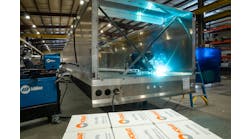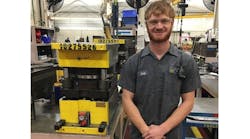The US Department of Labor (DOL) recently awarded a $12 million grant to Ohio’s Lorain County Community College (LCCC) through its Scaling Apprenticeship Through Sector-Based Strategies grant program.
LCCC was the lead grant applicant in a collaboration that included Ohio TechNet (OTN) and The Ohio Manufacturers' Association (OMA), collectively known as the Ohio Manufacturing Workforce Partnership (OMWP).
The funding will play a vital role in helping Ohio address the workforce shortage and skills gap affecting manufacturing, as manufacturers across the state have repeatedly cited workforce as their top issue of concern. With the funds, OMWP says it will upskill 5,000 Ohioans over the next four years through Industry Recognized Apprenticeship Programs (IRAP), an “earn-and-learn” model recently authorized by the DOL.
“Ohio manufacturers understand that it’s time to change the way we develop talent,” said Eric L Burkland, OMA president. “Industry Recognized Apprenticeship Programs take the best of traditional, registered apprenticeship—structured on-the-job training, with related classroom instruction and regularly increasing wages—and give manufacturers the flexibility to determine which skills and outcomes are most important to their long-term success.
“To ensure that these flexible apprenticeships provide high-quality training, each will be tied to a specific industry recognized credential.”
The grant is part of $183.8 million in funds the DOL awarded to 23 academic institutions and consortia with private-sector partners for training in information technology, advanced manufacturing and healthcare. The full list is available here.
The grants are funded through H-1B visa fees, which are paid to bring foreign workers to America when Americans cannot be found to fill open jobs, DOL said. The grants are expected to support the training of more than 85,000 apprentices in new or expanded apprenticeship programs and increase apprenticeship opportunities for all Americans, including veterans, military spouses, and service members transitioning into the civilian workforce; and grounds that are underrepresented in apprenticeships such as women, people of color and Americans transitioning from the justice system to the workforce.
“The apprenticeship model of earning while learning has worked well in many American industries, and today we open opportunities for apprenticeships to flourish in new sectors of our economy,” US Secretary of Labor Alexander Acosta said. “With 7.4 million open jobs and job creators searching for skilled job seekers, apprenticeship expansion will continue to close the skills gap and strengthen the greatest workforce in the world—the American workforce."
Burkland said the DOL opportunity came at the perfect time for Ohio manufacturers.
“For the last two years, we have been building a system of regional industry sector partnerships to foster collaboration and resource sharing among manufacturers and their education and workforce partners,” he said. “It was this systems-level work that prepared us to submit a compelling proposal to the Department of Labor.”
A key element of that system is Ohio TechNet, a consortium of Ohio's community colleges and other post-secondary education institutions, launched in 2014 with a focus on accelerating the readiness of Ohio's workforce for manufacturing careers.
“This is an opportunity to transform workforce development strategies to meet the needs of advanced manufacturers,” said Marcia J Ballinger, president of LCCC. “We couldn’t be more pleased to have this opportunity to deepen our work with The Ohio Manufacturers’ Association through the Ohio Manufacturing Workforce Partnership to ensure Ohio remains a leader in manufacturing talent innovation.
“Scaling apprenticeships in new and different ways is an innovation that works by providing opportunities for employers to build a workforce to spec, provide blended earn and learn models for individuals and fosters redesign of programs at higher education institutions to reduce time and cost to earn a degree and credential.”
OMWP’s project will focus on career pathways in advanced manufacturing with an eye toward technological advances, including Industry 4.0 and cybersecurity. To date, the partnership has secured commitments from Ohio manufacturers to train 2,315 apprentices.
“When we talk about respecting the dignity of work, that has to mean making sure our students have the opportunity to pursue jobs that pay well, that are fulfilling, and where they can build careers that lead to middle-class life,” said Sen Sherrod Brown (D-OH). “By investing in programs like LCCC’s, we can introduce students to the many opportunities available to them, whether they choose to pursue additional workforce training or get a job.”










